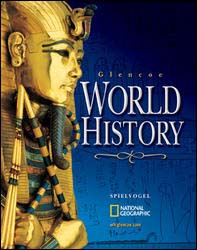Glencoe World HistoryChapter 6:
The World of Islam, 600–1500Chapter OverviewsThe religion of Islam arose in the Arabian Peninsula and gave birth to an Arab empire and a rich civilization. Across a massive expanse of territory, Islam provided the inspiration for art, architecture, literature, and philosophy. As dynasties rose and fell, power shifted to different centers, such as Damascus, Baghdad, and Cairo. Section 1 The Rise of Islam
For centuries the Arabian Peninsula was inhabited by loosely connected tribes. The tribes were polytheistic, but they placed special emphasis on the god Allah and on the Kaaba, a central place of worship in the town of Makkah. Muhammad, who grew up in Makkah, believed that he received revelations from God. Out of these revelations came the Quran, the holy book of Islam. Islam is a monotheistic religion with an ethical code consisting of the Five Pillars of Islam. Muhammad started preaching, but he and his followers were persecuted in Makkah and so moved to Madinah. There Muhammad became both a religious and a political leader. After eight years, he led a military force that easily conquered Makkah. Section 2 The Arab Empire and Its Successors
After Muhammad's death, the Arabs rapidly embarked on a period of massive conquest. Since there was no established line of succession, disputes and assassinations marked the rein of the early Muslim rulers, or caliphs. Under the Umayyad dynasty, an ill-fated revolt led to a permanent schism that divided Islam into two branches—Shiites and Sunnis. The Abbasid dynasty displayed a greater openness to non-Arab participation in civic life and oversaw a thriving trading empire. However, Seljuk Turks began to take over parts of the Arab empire. When they threatened the heart of the Byzantine Empire, European crusaders came to the aid of the Byzantines. The century of Crusades did not have an enduring influence, except to create enmity between Christians and Muslims. A century later, Mongol invaders swept through the region, destroying entire cities. Egypt, which remained free of Mongol control, became the center of Islamic civilization. Section 3 Islamic Civilization
Overall, the period of the Arab Empire was prosperous. Aided by the development of banking, the Arabs carried on extensive trade by land and by sea. Cities such as Baghdad, Cairo, and Damascus were the regional centers. Meanwhile, farming remained the source of livelihood for most people. In this diverse context, Islam offered answers concerning politics, economics, and social life. Islam held that all people are equal in the eyes of Allah. In reality, however, equality was not strictly the case. Class divisions were common, and both slaves and women faced various restrictions. Slaves, though, sometimes could gain their freedom. Early Muslim women enjoyed many rights, but these rights were eroded by older customs and traditions. Section 4 The Culture of Islam
A major cultural contribution of the Arabs was the translation of the works of major Greek philosophers into Arabic. It was through the Muslim world that Europeans recovered the works of Aristotle and others. The Muslims were also thinkers and creators in their own right. Islamic scholars wrote commentaries on Greek philosophy, developed algebra, and made important contributions in astronomy, navigation, and medicine that would be adopted in Europe. In a major work, the Arab historian Ibn-Khaldun argued for a cyclical view of civilizations. The great works of Middle Eastern literature included the Rubaiyat of Omar Khayyam and The 1001 Nights. Mosques from Iraq to Spain offered magnificent examples of Islamic art and architecture. Ornately decorated palaces, such as the Alhambra in Granada, Spain, also reflected the glory of Islam. Islamic art typically consisted of Arabic letters, natural plants, and abstract figures repeated in geometric patterns called arabesques. However, human representations were avoided in accordance with Islamic tradition.  | 

















